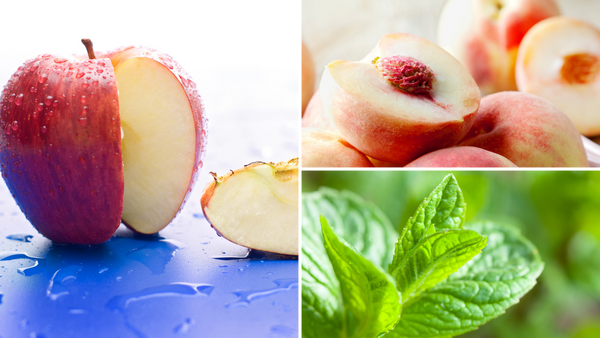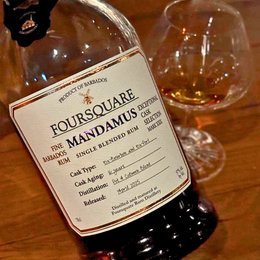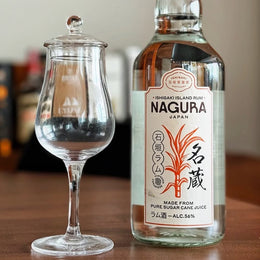Monymusk "Colours of Singapore", 2002, 18 Year Old Jamaican Rum, 60.5% ABV, Bottled by Interco-MLE and M&E Drinks
Jamaica has a few things in common with Singapore. Both are island states, enjoy tropical weather and share a British influence in their early history. Both also have vibrant drinking cultures.
With air travel restrictions and whatnots these days, I suppose we can at least rely on a dram to take us on a trip to the Caribbean. I got to uncork this bottle of Monymusk Jamaican rum with a quaint bottle art and a yellow gold colour that would look familiar to many a Scotch drinker. This was distilled by Jamaica’s Clarendon Distillery, based in the eponymous Monymusk Estate, one of the oldest sugar cane plantations on the island.

We don’t often get to see originally-produced bottles of Monymusk Estate rums. Why? A good 90 percent of Clarendon Distillery’s distillate is procured by Diageo to create labels such as Captain Morgan and Myers's rum. Then, much of the remaining 10 percent is sold to indie bottlers. Only the remainder is left for Monymusk Estate. As a result, the most accessible way to get our hands on some single-estate Monymusk rums is through indie bottlers.


(Image Source: Diageo)

(Image Source: Myers's)
Clarendon Distillery makes its distillate by fermenting molasses and distillation using a combination of pot stills and column stills. But the classic British-Jamaican style of rums is also famously defined by a distinctive funky flavour reminiscent of overripe bananas. The local Jamaicans refer to this as "hogo" (from the French phrase "haut gout", meaning "high taste").
How is "hogo" added? The Clarendon Distillery adds 2 ingredients to the pre-distillate, known in the industry as "dunder" and "muck". Dunder refers to the sticky remnants at the bottom of the pot still after a batch of rum has been distilled. Muck refers to a pungent and sour mixture of fermented dunder that is full of complex flavour compounds. After distillation, the result is a spirit full of intense fruity aromas similar to over-ripe tropical fruits that Jamaican rum lovers adore.
The bottle
Today’s juice was bottled by Singaporean spirits curators INTERCO-MLE and M&E Drinks. Interestingly, rums are heavily affected by their place of maturation- whether it is in the tropics, or in Europe (i.e. continental aging). This 18-year-old rum was primarily subject to continental aging in a single ex-bourbon cask, and the results would certainly show when you taste it.

One huge factor in a rum's flavour is the climate in which it was matured. Tropically-aged rums tend to be dark, heavy and intense, while continentally-aged rums tend to be much lighter and more elegant.
The expression is aptly-titled “Colours of Singapore” as it features a vibrant impressionist painting of post-WWI-style warehouses and heritage shophouses that one would find walking along the Singapore river in the 1900s. The island state was once a colonial trading post for the British. And if you stare at the art long enough, you might just begin to see 19th century Chinese labourers unloading barrels of imported rum into those warehouses.

Let’s dive right into tasting this.
Tasting notes
Colour: Old gold with quick legs.
Nose: On the nose, this is rich, estery and tropical.
This opens with a fruit basket full of tropical fruits. Initial notes are rather sweet, with mildly funky overripe bananas and grilled pineapples. Peeking through the sweetness is a slight tartness of mangoes, mangosteens and duku-langsat.


Effects of the continental aging are obvious here. There is an air of refinement and quite a bit of balance. The typical Jamaican rum funkiness is really on the low key here, and the alcohol is quite gentle on the nose despite the very high proof.
Bookending the experience is a hint of a solvent note seen in many grain whiskies (if you have tried the Nikka Coffey Grain whisky), and a light touch of liquorice.

Addition of some water reveals distinct notes of honey and vanilla, while tartness dissipates.

Palate: The palate is rich, briefly intense in flavour and has sweet and tart fruits.
This opens with a quick but intensely sweet touch of passion fruit and mangoes complimented by refreshing Bundaberg root beer. There is also almost a nutty, salted-caramel savouriness present in the background that really helps to draw out the sweet and tart flavours.

Some heat and spice builds at the back palate, but this is quite comfortable and pleasant, and it helps to bring out more sweetness and nuttiness.

The intensity of the initial palate very quickly takes its leave, transitioning into brighter notes of honey, mild vanilla oakiness, maltose candy.

Once again, texture and flavour are very moderate and refined due the continental aging. While this feels on the weightier side compared to the typical Scotch, it is very light in comparison to tropically aged Jamaican rums from Hampden Estate and or Worthy Park.
This holds up pretty well with a splash of water. The dram brightens considerably, while spice, tartness and intensity begin to recede. There is more sweetness now, but in a much gentler and milder way with lots of fresh apples, white peach and a light peppermint note.

Finish: The finish is long and clean with a lasting note of honey and candy floss, a slightly dry sourness evocative of hawthorn candy (山楂) and a mild oakiness.

My take
Jamaican rums are famous for their pungent, overripe banana notes, or what’s known as “funk”. But funk is divisive- I know of rum devotees who are obsessed with extra-funky Jamaican rums, and rum devotees who avoid funk like the plague. In a sense, funkiness in rums is almost like peatiness in whiskies.
I personally prefer to funk to be on the lower side, so this aspect of the bottle is sublime for me. I haven’t conducted surveys, but I suspect most drinkers in Asia would prefer less funky rums too. And in that regard, this Monymusk is great for how effortless to drink it is. Typically, one would expect a very intense, spicy and funky kick from a Jamaican rum. What we get here instead is a very gentle introduction to the funk, fruitiness and spice at a very comfortable intensity. Still, there is little bit of sharpness present (in a good way) to draw out flavour and add complexity.
Our Rating |
🍰Just like a piece of cake, this has almost universal appeal from beginners to devotees. I love that it so gently introduces all the flavour elements of a rum to beginners with its refined flavours. I also like that it still has some complexity and “kick” to keep things interesting and provoke long-time rum drinkers. If you’re a Scotch drinker who has not tried aged rums, you might really enjoy this. |

@charsiucharlie
Leave your thoughts and comments on the review in the Forum







